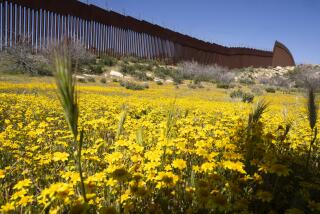‘Indiana Jones’ of Botany Chases an Elusive Herb
- Share via
SAN LUIS OBISPO — There is an obscure herb that grows along the cliffs in a remote Hawaiian cloud forest, one of the rainiest and most inaccessible places in the world.
Botanist Michael Doyle became fascinated with this herb as a graduate student, but to study it he had to get to the cloud forest. And to get to the cloud forest--higher in elevation than a rain forest--he had to take risks not usually associated with plant gathering.
During Doyle’s search for the herb, called gunnera, he has dangled from helicopters to snatch samples from the sides of mountains. He has slogged through terrain so muddy and thick with vegetation that it took three days to travel a mile. He has rappelled hundreds of feet down crumbling cliffs to reach unusual species.
His expeditions have been so dramatic, so antithetical to the insular lab work of most scientists, that colleagues refer to him as the Indiana Jones of botany.
A Hawaiian scientist once told Doyle, now a visiting professor at Cal Poly San Luis Obispo, that he, too, was interested in the herb. But he refused to search for samples, he told Doyle, for one reason: “I want to live.”
Doyle, the world authority on Hawaiian gunnera, is willing to take risks, he said, because scientists can learn much from the herb. Gunnera can survive in the poor soil of rugged terrain because, in essence, it manufactures its own fertilizer. If scientists could better understand this unique food-producing system and, with genetic engineering, apply it to other plants, it would be extremely significant, Doyle said.
“This could be a way to solve world hunger,” he said. “Imagine being able to grow a variety of plants in very poor soil . . . and never having to fertilize them.”
Gunnera has many other unusual properties, and Doyle never tires of talking about them. Hour after hour, with no discernible drop in enthusiasm, he discusses his pursuit of gunnera, displays countless photographs of gunnera plants, pulled out stacks of paper with pasted gunnera samples and gives lengthy disquisitions on the unusual botanic properties of gunnera.
While many of Doyle’s contemporaries are rising through the corporate ranks and raising families, he finds himself, at 34, living alone in a house he has temporarily sublet, about to lose his first full-time teaching job because of state budget cuts and spending his summers living in tents. His obsession cost him his marriage, and he continues to live the rootless life of a plant vagabond.
“When you’re working all night long at the lab, studying the plant, sleeping all day and traveling on your time off, well, it’s hard to keep a relationship together. . . ,” he said softly. “But this is my quest, my Holy Grail.”
Doyle, who wrote his doctoral thesis on the herb and received his Ph.D last year, knows more about Hawaiian gunnera than any other botanist in the world, said Ron Scogin, a professor at Claremont Graduate School. This, however, is partly by default. The herb long has been ignored because most scientists are unwilling to endure the rigors of gathering it.
“Putting your life on the line is not a standard prerequisite for a Ph.D in botany,” said Scogin.
Doyle always has been interested in arcane subjects and uncharted territory. Before he enrolled at Claremont, he studied rare species of fungi and wrote a master’s thesis entitled “A Floristic Survey of Fleshy Fungi From the Hawaiian Islands.”
“I’m attracted to the underdogs in the plant world, things that are neglected and not well understood,” Doyle said in his office, a small, windowless jumble of seed collections, plant samples, gunnera slides and mountain climbing equipment. “Some people like to study fruit flies in a lab. I like being a pioneer.”
Doyle discussed the first time he saw a gunnera plant with the reverence people usually reserve for religious epiphanies. He was searching for a rare species of fungi on the Big Island of Hawaii when he spotted the plant, an enormous, brilliant green herb with rippled leaves as big as parachutes. It grew along the face of a 3,000-foot cliff, surrounded by waterfalls, at the edge of a vaporous cloud forest.
“The plant was so remarkable and the setting was so beautiful, I was just . . . it was so. . . .” Doyle paused in mid-sentence, nervously scratched his beard with a fist and struggled for words to describe the experience that changed his life. “I was overwhelmed.”
He eventually returned to the cloud forest and spent two weeks traversing the rugged terrain with a pack on his back. But this time he couldn’t locate any gunnera plants.
After a number of arduous backpacking trips, Doyle met a helicopter pilot who suggested he try “long-lining”--wearing a harness and dangling from a 150-foot line connected to a hovering helicopter.
He was able to snatch more than 17 different types of gunnera off the steep cliff sides in an hour, which normally would have taken him years to collect.
Doyle’s adventures in the field, he said, aid him in the classroom. When he shows slides of his plant gathering trips, or recounts some of his more harrowing experiences, students respond enthusiastically.
“They see that botany in not just a bunch of guys in lab coats looking at plant samples,” he said.
While there are other varieties of gunnera that grow in less spectacular surroundings, Doyle is intrigued by the species found in Hawaiian cloud forests. Because it grows in such isolation, it has many unusual features.
Hawaiian gunnera could be more than 1 million years old and the species has changed very little, although it grows on islands where rapid evolution is common. Doyle said that as a result, scientists may one day learn a great deal about the evolutionary process.
Another feature that makes the plant interesting to study, he said, is the great variation in size. Gunnera is the world’s largest herb, with leaves up to 10 feet wide, but some varieties are tiny and have only half-inch leaves. Through studying the herb, scientists could gain insight into how to increase plant size, Doyle said.
Gunnera can grow along rocky cliffs in very thin soil by using the algae in its stems to absorb nitrogen from the atmosphere, then convert it into fertilizer. Gunnera is the only flowering plant with this capacity.
When Doyle completes his research on Hawaiian gunnera, his travels will not be over. He will have plenty of time to research other varieties of the plant since his one-year teaching contract at Cal Poly expires this summer and will not be renewed because of budget cuts.
He plans to apply for research grants and investigate how gunnera seeds were transported to Hawaii--probably by birds--and study the plants’ ancestors. Doyle assumes the seeds originally came from South America. But researching plants there will not be as arduous as slogging through the cloud forests searching for samples of Hawaiian gunnera.
The South American variety grows right by the sides of heavily traveled roads, so Doyle will be able to collect samples without leaving his car.
More to Read
Sign up for Essential California
The most important California stories and recommendations in your inbox every morning.
You may occasionally receive promotional content from the Los Angeles Times.













